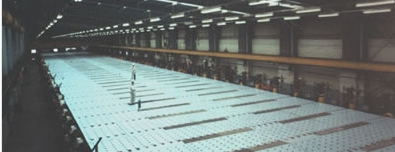CELL ROOM MONITORING
The chloralkali industry produces chlorine and caustic soda for awide range of industrial uses. Caustic soda (NaOH) is the Chemical Industry’s most important alkali. |
|
There are three technologies used for the manufacture of caustic soda, namely, mercury cell, diaphragm cell and membrane cell. The mercury cell process is historically the oldest technique and predominates with over 350 plants worldwide, with 13 in the USA and 3 in the UK. Since the Minamata Bay incident (1950’s) the use of mercury cell technology has been forced into decline, with the 1992 Rio Summit Conference stipulating that all mercury cell plants should be phased out by the year 2010. Approximately 72% of the UK chlorine capacity is based on the mercury cell process. |
 |
A typical chlor-alkali cell room can contain as many as 100 mercury cells (covering an area of 3 football pitches). Each cell contains approximately 5 tonnes of elemental mercury. The cells consume mercury by releasing the metal by different routes:
Some cell rooms use a high velocity ventilation system to withdraw air from the vicinity of the mercury cell and expel the contaminated air to atmosphere. At present, monitoring of the ventilation system is performed manually. Manual monitoring is performed using a hand-held mercury “sniffer”. This is a simple device based on pumping a sample of air through a UV cell for determination. Drawbacks of the sniffer include:
On-line monitoring enables the plant supervisor to notify areas of high mercury concentration and therefore contamination by either a spillage or plant malfunction and also provide mass balance data The PSA 10.210 Cell Room System has been developed to determine gaseous mercury in air samples with full process and data control being achieved by use of a computer located remotely within a control room. The system is capable of rapidly scanning an entire cell room (36 air vents) within a 40 minute period. The plant operator has the ability to focus the analysis on individual “hot spots” within the cell room, thereby correlating mercury levels with other process parameters. To discuss particular requirements and for more detailed information on the above products please complete the Information Request Form. |
|




